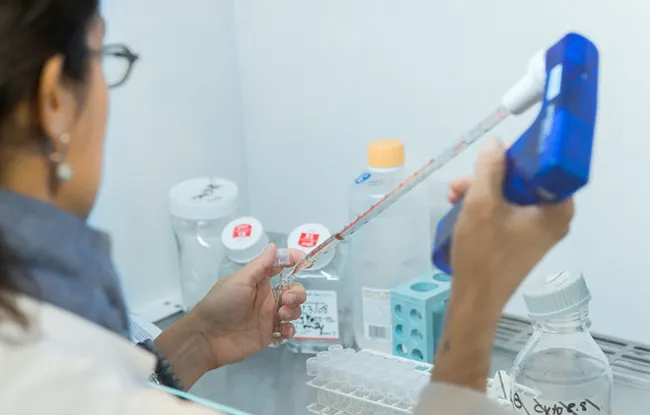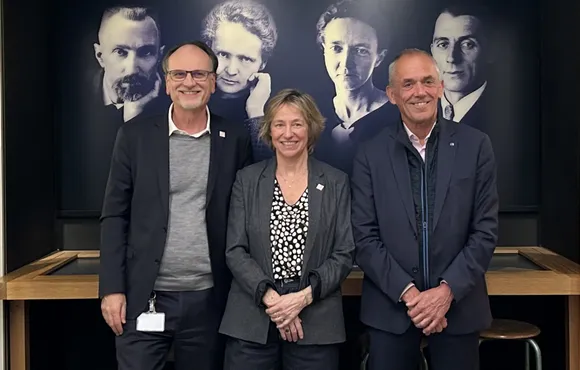- Home >
- Institut Curie News >
- Prostate cancer: non-coding RNAs in the urinary extracellular vesicles are now in play
This research is the result of a collaboration between Institut Curie, Inserm and Hôpital Henri Mondor and is published in the Journal of Extracellular Vesicles.
Extracellular vesicles (EVs) are small particles (50 to 1,000 nanometers, 10-9 meters) which are secreted by all cell types and are present in all bodily fluids, such as blood and urine. These EVs contain lipids, DNA, RNA and proteins. They travel and communicate with nearby or distant cells, transferring their contents. These small particles can thus play a significant role in the development of cancer, by communicating crucial information to the tumor microenvironment. One of the avenues of interest for research on EVs is to study their capacity to act as carriers of disease biomarkers, which enables non-invasive methods of diagnosing and monitoring a patient’s response to treatment. In addition, by acting as antigen carriers, EVs can trigger pro- or anti-tumor immune responses.
At Institut Curie, the teams of Antonin Morillon, director of the “Dynamics of genetic information: fundamental bases and cancer (DIG-CANCER)” unit (Institut Curie, CNRS) and Clotilde Théry, research director at Inserm and team lead in “Extracellular vesicles, immune responses and cancer” at Institut Curie[1] were able to analyze and describe the complexity of RNAs in the urinary extracellular vesicles extracted from patients with prostate cancer (Figure 1). They compared them to RNAs from the original tumor. They also analyzed long non-coding RNAs (lncRNAs), using high-throughput sequencing and in-depth bioinformatic analysis.
|
Figure 1: Visualization of intact urinary EVs after enrichment. Urinary EVs visualized by electron microscopy. The yellow arrows show some examples of uEVs of different sizes. |
The analysis showed that RNAs (both coding and non-coding) in the urinary EVs allow protein translation. Long non-coding RNAs - some of which are already known for their role in cancer development - include circular (circ)RNAs (Figure 2). A comparative study of three prostate cancer cell lines revealed that 14 circRNAs are essential for the in vitro proliferation of prostate cells. In addition, 28 long non-coding RNAs found in the urinary EVs belong to classes known to be related to cancer (CLC, Cancer LncRNA Census).
|
Figure 2: Comparative enrichment of lncRNAs in urines. Heat map representation of cirRNA levels in tumor versus urines of the prostate cancer patients. |
Long non-coding RNAs, originally defined as RNAs that do NOT code for proteins, can produce peptides, however. The scientists revealed that certain long non-coding RNAs in the urinary EVs not only produce peptides but can also produce potential tumor antigens. Researchers suggest that the tumor cells release EVs containing these long RNAs coding for tumor antigens. These antigens could be received, internalized and translated by a neighboring non-tumor cell, which would then have tumor-specific surface antigens. The immune system would thus aim for these non-cancer cells.
This dual RNA analysis (long non-coding and circulating), both in urinary EVs and in vitro cells, provides a unique, essential resource for future phenotype characterization of these RNAs, as well as the associated peptides, involved in prostate cancer.
|
Reference Almeida, A., Gabriel, M., Firlej, V., Martin-Jaular, L., Lejars, M., Cipolla, R., Petit, F., Vogt, N., San-Roman, M., Dingli, F., Loew, D., Destouches, D., Vacherot, F., de la Taille, A., Théry, C., & Morillon, A. (2022). Urinary extracellular vesicles contain mature transcriptome enriched in circular & long noncoding RNAs with functional significance in prostate cancer. Journal of Extracellular Vesicles, 11, e12210. https://doi.org/10.1002/jev2.12210
|
[1] The research involved the technological facilities at Institut Curie (Extracellular vesicles, high-throughput sequencing, ICGEX, proteomic mass spectrometry), as well as Prof. Alexandre De La Taille’s department and Francis Vacherot’s team (Hôpital Henri Mondor).





